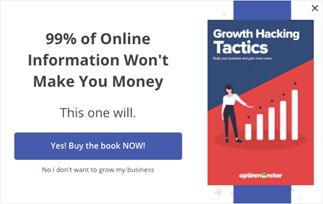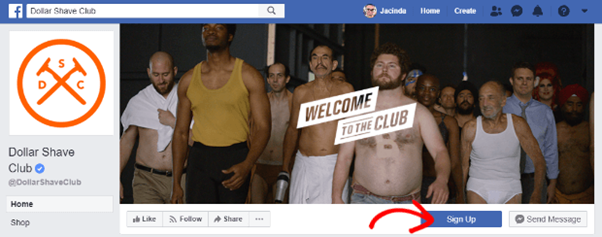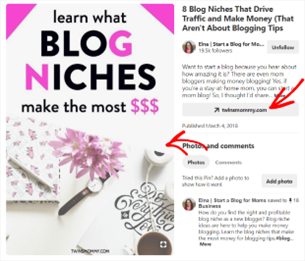Sarah is a brand manager for an online jewellery company. She’s new in the role, wants to make a great first impression and get some quick wins on the board. She’s responsible for all the advertising, social media and email marketing.
It’s the email marketing that’s worrying her.
Whilst she knows the basics of how to create and execute a basic email newsletter campaign, she doesn’t feel confident using the latest email technology or tools. Her remit is to build the email list, quickly.
Here’s a few quick and easy ways she can use the latest email tips and techniques to build that all important list:
1. Use a pop-up to grab attention
Let’s start with the basics. What’s a pop-up? A pop-up is a small window that appears on top of your content while browsing a website. It contains a compelling offer or promotion that captures your visitor’s attention quickly and gets them to sign up to something. In short, pop-ups are used to generate leads.
Unsurprisingly, not everyone likes pop-ups. SEO experts believe they interfere with the user experience and therefore reduce the website’s SEO ranking. Users (or website visitors) complain that they are a nuisance and get in the way. (Apparently, even the founder of the pop-up technology, Ethan Zuckerman apologised for making them. He wrote an open letter to the internet that said, quite simply, ‘I’m sorry.’).
But digital marketers and brand managers like Sarah love pop-ups because they can build a list very quickly, if they are designed and executed correctly. The key word there is IF they are designed and executed correctly.
Here’s a few tips on how to do that so you don’t lose your SEO rank or annoy your customers.
a) Choose the right pop-up for the task at hand
All pop-ups are not created equal. There are around 50+ types of pop-ups so don’t fall into the trap of thinking one pop-up can be used for every occasion. Before you launch your pop-up campaign, you need to think about:
- What are you selling?
- Who are you selling to?
- What stage of the buyer journey are they at?
- What do you want the pop-up to achieve?
Once you’ve done this basic research, you can move forward. Pop-ups are super sophisticated now and can be timed to pop-up at specific times, in a specific location on the web page, and to specific people.
If you’re like Sarah and just starting out on your pop-up ‘journey’, it’s best to keep it simple. Here’s 3 of the easiest and most popular pop-ups to consider:
1. Lightbox pop-ups
Lightbox pop-ups are one of the most common types of pop-up. You’ve no doubt seen them. They appear in a smaller new window over the web page you’re currently browsing. When a lightbox pop-up shows up, it makes the background of your browser look darker to really grab your attention. (That’s why it’s called a Lightbox). They look like this:

2. Yes/No pop-ups
A Yes/No pop-up is a pop-up which shows a simple “yes or no” question to your visitor. They’re powerful because they make it easy for the visitor to say ‘yes’ quickly, reduce decision making and when written well, make the offer easy to understand and digest. Yes/No pop-ups also succeed because they don’t ask you to immediately give up your email address, which can scare visitors away. By asking a simple “yes” or “no” question upfront, you’re more likely to get people to take action after they click “yes.” (Why is this? We don’t really know but a Soviet psychologist by the name of Bluma Zeigarnik discovered that once people commit to a process of some kind, they become keenly invested in completing it.)

3. Full-screen pop-ups
A full screen pop-up does as the name suggests - it covers the entire browser screen that your visitor is viewing. Here’s an example of what a full screen pop-up looks like:

Digital marketers are hesitant to offer full screen pop-ups because they fear the visitor will abandon the website altogether. However, our research showed that a full screen pop-up is 15-50% more effective in converting browsers into subscribers. The full size did not ‘shock’ the visitor, or ‘put them off’ from staying longer. In fact, they treated the pop-up as part of the browsing experience and assessed it as if it was part of the website, not just a marketing tactic to be dismissed.
Here’s 7 other common types of pop-ups to consider:
- Yes/Yes
- exit-intent
- slide-in scroll boxes
- floating bars
- after post opt-ins
- 2-step opt-ins
- gamified
(By the way, don’t let the pop-up appear straight away and get in the way of the user experience. Let the reader have a moment’s peace (for about 8 seconds) and then let it rip.)
b) Create a valuable offer
A pop-up needs to grab the visitor’s attention instantly so you need to create a compelling offer that is too good to refuse. Making it relevant to the visitor is critical, so do your research to find the right offer, for the right person, at the right stage of their buying journey.
For example, if Sarah, the brand manager for a jewellery company, was targeting a new user, she could offer them 10 per cent off their first purchase as an incentive to sign up to the newsletter. If she was targeting an existing customer coming back to the website, she could offer them ‘free shipping on orders over $150’ to incentivise them to buy again. Think carefully about who you’re marketing to and tailor your offers accordingly. Don’t make the mistake of giving the same offer to everyone.
Here’s some popular offers that work well:
- 15% off first order
- $15 off first order
- Free shipping
- ‘Subscribe and win a prize’
- ‘Buy one get one free’
- ‘Refer a friend and get a free gift’
(I often get asked, ‘What number works best for discounts and dollars off? We’ve found that 15% or $15 dollars off has been proven to be a sweet spot discount for ecommerce businesses. Why? Because anyone can get 10% off (just by asking nicely); 20% is too much for the retailer to give away; 15% or $15 is high enough to be valuable to the consumer, but not so high as to wipe out the retailer’s profit margins).
c) Use ‘dollars off’ rather than a discount
A/B testing will tell you what offer works best, but our research has found that a ‘dollars off’ offer works better than a ‘discount’ offer, even if the discount value is higher than the ‘dollars off’ amount. For example, we ran a test where we compared 10% off a $300 necklace (a saving of $30), versus $10 off the same $300 necklace (a saving of $10) and the latter outperformed the former by 40%, even though the first offer delivered the consumer an extra $20. It seems that customers perceive dollars to be more ‘real’, and some customers just don’t have the time, mental bandwidth or inclination to calculate what their discount will be.
d) Use short, punchy copy
Words matter, and make a massive difference to the way people respond. For example, words like ‘sign-up’, ironically, deter people from signing up. After all, who wants to receive more junk mail? Try using power words that inspire people to take action. Words like “Instant download,” “Get it here” or “Watch now” always work well. Choose from this list of the Top 100 Power Words and watch your Conversion Rate soar.
If you can, add some humour or wit to your words to let the visitor know that there’s a real person behind the button. For instance, which offer for this financial planning firm is more likely to make you click through? ‘Yes, sign me up for more emails!’ or ‘No thanks, I don’t want to make any more money.’ Most people prefer the latter. The conversational tone of the second one cuts through the clutter and incentivizes us to take positive action. Note the sarcasm too. That edgy little touch builds rapport and gives the reader a little giggle.
e) Don’t ask for too much data
In an ideal world, we’d ask the visitor to give us their first name, last name, email, mobile, their birthday, their dog’s name, the dog’s birthday, and more. But of course, the user is busy and unlikely to do anything of the sort. Best practice is to just ask for their first name and email and then ask for more information on the second, third or fourth pop-up page. (As the Zeigarnik Effect noted, once people complete the first page, the user is much more likely to complete subsequent pages). But if you’re just launching your first pop-up campaign, keep it simple, and ask for their first name and email.
(Why ask for their first name? Because when you launch your welcome email sequence, you can personalise your communication with them. Sending an email starting with ‘Dear Belinda’ versus ‘Hi there’, will always deliver a better result).
As you get more experienced and confident with executing pop-up campaigns, feel free to add more and more pages to the campaign. I often get asked, ‘How many pages should you have on your pop-up?’ The answer is, ‘more than you think.’
Conventional wisdom would say that adding more steps to a process would reduce conversion rates. In fact, it’s the opposite. Depending on your goal, you can add two to seven more pages to the pop-up and still have the reader answer every question and submit the form. Why would you add that many pages? It’s all about data collection and customisation. The more questions you ask, the more data you collect, the more customised the offer can be.
2. Run a competition:
Competitions are great ways to build a list quickly, but there are a few traps you need to avoid to ensure the competition retains its integrity. Firstly, it’s important to know that spammers often send in their bots (robots) to enter a competition multiple times.
The impact can be very distressing for an inexperienced brand manager. For a start, your list will be filled with fake users; you’ll attract subscribers who will never buy; you’ll pay to send future emails to them and you will possibly award the prizes to those who will never become your customers. In short, your competition will be a monumental waste of time, effort and money.
If you are going to offer competitions, get serious about it and use a reputable tool like Viral Sweep to create and administer the give-away form for you. For a very small fee, you’ll protect your competition from being spammed, build your list and protect your sender reputation.
a) Make the offer relevant
Choose your competition prize carefully and make it relevant to the target market. Sarah, the brand manager, sells jewellery so it would be pointless for her to offer an iPad as a prize. Well, she could but it wouldn’t work because she’d have a bunch of teenage boys sign up to her list. They’re not her ideal client so it’s a waste of effort. But a prize like ‘Win a $500 wardrobe’ is going to attract a higher quality target and importantly, repel those who aren’t. You don’t just want anyone on your list. You want quality prospects; people who are willing, able and ready to buy.
b) Collaborate with others
The point of a competition is to build your database but you can only promote it to those who are already on your database. So, how do you find new people to target?
One of the best ways to do this is to collaborate with other brands who have a similar target audience to you. That’s where brand collaborations come in. Also known as strategic alliances, joint ventures, or partnerships, brand collaborations are a fast, affordable and effective way to generate new subscribers. Who should you collaborate with? Sarah sells jewellery, so it would make sense for her to partner with a fashion company, a make-up company and a shoe company so they can all contribute relevant prizes.
These multi-brand collaborations can exponentially build your list. Here’s a few tips on how to run a multi brand collaboration:
Be careful who you collaborate with
Choose your collaborators with care. Do your research to ensure they have the same target market as you, have similar corporate values and principles, and most importantly, a bigger list than you! There’s not much point collaborating with a brand that doesn’t have a sizeable database.
How does multi brand collaboration work? It’s quite simple. Here’s the 5-step process for creating a successful campaign:
- You create one landing page that promotes all the prizes
- You create one sign-up or CTA button
- The brands all promote the competition to their respective databases
- The readers all sign up using that one button
- When the competition ends, you all get access to the subscriber’s data
You can see how it works, right? You leverage all those other brands’ databases to generate new subscribers and you get access to all the new subscribers that join. It’s a great way to take advantage of other, larger databases that you don’t have access to. There’s a few tricks to making the most of your multi-brand collaborations. Here’s a few of them:
Start your welcome sequence before the competition has finished
Most brands think they need to wait until the competition is finished before they can start to make contact with the new subscribers. This erroneous belief is based on the fact we think our new subscribers want to see if they’ve won something in the competition before they’ll buy from us. This is generally not the case. They sign up to you because they are interested in what you offer, and hope that they may win something down the track, but they are not waiting to find out before they begin buying.
It’s infinitely preferable to make contact with those new subscribers as quickly as possible. Why? Because the minute they sign up to the competition, they are what’s known in the business as ‘hot to trot’. That’s not a technical term, but in other words, they have demonstrated that they are interested in you and what you have to offer and reaching out to them at that moment is without a doubt the best time to send them something. Leave it for too long and they’ve forgotten they ever entered the competition. In fact, our research showed that brand recall all but disappears around 14-21 days after they sign up or enter the competition.
Take responsibility for building the landing page
If you go down this multi brand collaboration route, it pays to take responsibility for building/owning/controlling the landing page design and construction. Why?
Because you get instant access to the new data! Why does that matter? Because getting instant access to the data means you can launch your welcome sequence the moment the visitor subscribes.
Even if you don’t control the build or the design of the landing page, remember to ask for the data as it comes in, make that request part of the negotiation and start contacting those subscribers as soon as they enter the competition.
By the way, if you are the organiser of the promotion, be careful not to overpromise to the other collaborators about how many subscribers you will amass. You can’t know what technical trouble you will run into and spam traps will no doubt raise their ugly head, so err on the side of caution and undersell what results you think you can deliver. If it goes better than expected, you’ll look like a superstar.
Ask for permission
People are hyper-sensitive about how their data gets used, so it’s critical you be explicit about what data you are collecting and what you plan to do with the data. If you’re running a multi brand collaboration, make sure your terms and conditions specify that subscribers give permission for ALL brands to contact them, and remember to list those brands and their names in full so that there is no ambiguity as to who is part of the promotion, and what emails the subscriber can expect to receive.
How do you get brands to collaborate with you? Ask nicely and create value. Don’t reinvent the wheel trying to write the proposal. Download our free Brand Collaboration Pitch Email here and use this to invite other brands to collaborate with you.
In summary, here are the top tips for making a multi-brand collaboration campaign work for you:
- Contact like-minded companies with large databases and invite them to be a part of the campaign
- Offer prizes that are relevant to the target market
- Launch the landing page
- Promote the campaign to the databases
- Get in touch with the subscribers as soon as they enter the competition
- Take ownership of the promotion so you can get early access to the data
- Get explicit permission from the subscriber to accept emails from all the brands
3. Leverage your socials
Using social media to build your email list is one of the quickest and easiest ways to ramp that list up without spending a lot of money. There’s a lot of ways to leverage your socials. Here’s a couple of them:
a) Run a ‘Look-a-like’ Facebook campaign
A little-known but effective strategy is to use a platform like Facebook to find ‘look-a-like’ customers. This technique helps Facebook identify who to show your advertisement to. Here’s how it works:
- Upload your targeted email list (using a CSV file) to Facebook.
- Facebook looks for accounts that match that profile
- Facebook then runs its algorithm over the profiles, sees the commonalities and predicts the kinds of people who would be interested in the offer
- Facebook then shows them that advertisement
With some popular email software products, such as Klayvio, you don’t even have to upload the CSV list to Facebook. Klayvio will connect your database to Facebook for you, making it a super easy and streamlined way to conduct your look-a-like campaign.
You might be wondering: How many email addresses do you need to upload for Facebook to identify a relevant ‘look-a-like’ group? Not as many as you think. If you have around 100 email addresses Facebook will get what it needs to work out what kind of customer profile you have.
Worried about duplications? Don’t be. When Facebook creates that look-a-like list for you, Klayvio will then find the duplicates in that list and eliminate them so that you’re not advertising to those who are already on your list. You’re paying Facebook to find new leads so you don’t want it showing advertisements to people who are already on your list. If you care about saving money, being efficient and getting maximum bang for your advertising buck, then ‘look-a-like’ campaigns can be of great value.
b) Promote your offer on your socials
Your social network can be very useful in building your email list. For example, once you create your offer, get cracking and plaster it all over Twitter, Facebook, Instagram and LinkedIn, and you can easily grow your list without effort. These followers already know, like and trust you so why not give them the opportunity to subscribe to your offer. If you haven’t already created an email newsletter, do so, and add the offer as a link to your email signature. Dollar Shave Club (who are pretty good at every form of marketing) included a call to action on their Facebook page to encourage visitors to sign up for their mailing list like Dollar Shave Club:

Here’s a nice demonstration of how to use a Call To Action on Instagram and build your list.

There are endless ways to use social media to build your email list. Try a few, measure the results and see what works.
Why not just buy a list?
Building an email list from scratch is hard work which is why many are tempted to take the short cut and buy a list. In a word, don’t’. It rarely pays to buy an email list. It’s simply not worth the cost, in terms of money, time, or hassle. Instead, grow your own targeted, responsive list of potential customers who are eager to hear from you, and you’ll see far greater success!
In conclusion:
Sarah may be new at her job and trying to get up to speed with how to grow her list quickly, but if she applies a few of these strategies and takes the time to test and measure the success of each, she’ll find her list grows quicker than she thinks.
If you’d like to learn more about how to grow your email list, click here to receive our Ultimate Email Checklist template.
You can also enrol in our Email Marketing and Copywriting course to learn how you can become a fully qualified email marketer and copywriter.


